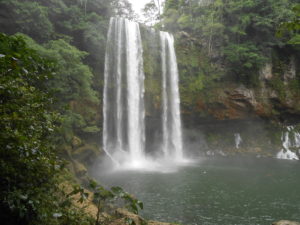Nicolás Arcos López
- The Water Lord (Jiñi Yum Ja’).
- In San Miguel, Salto de Agua, Chiapas, there is a waterfall called Misolha (from misol ‘sweep’, and ja’ ‘water’) ‘fall of water’. Today this place is one of the major tourist centers of the municipality, and is frequently visited by people from different parts of the country and from abroad. But the first settlers who encountered the waterfall tell of the dangers that the yum ja’ (water lord).
- One evening, when the Ch’ol people were searching for land for planting, they heard the sound of water in the distance. They were tired and quite thirsty, so they went in search of the water, but they never imagined that they would run into the yum ja’ there. At that time, he did not show himself in person, but he used the ik’ (air), the ja’al (rain) and the mam (lightning) to send messages.
- The first thing that impressed people was the height of the falls and the rainbow that formed above the water. Then suddenly, a voice was heard saying…
- “I know that you were expelled from your community and have nowhere else to stay. That’s the only way I let people enter my house. But as for the people who do not respect my house I will not respect them either, and that’s how it will be with your wives, brothers, and children.”
- After having listened to the yum ja’, the group felt sad and unsure about his welcome, because they did not know what to expect, or what would happen to them if they did not fulfill his wishes. The next day, the small group of Ch’oles left again for their places of origin to go in search of their relatives and other people who had wanted to found a new community.
- Once the Ch’ol people managed to settle near the waterfall, they started hunting animals for their food, they started logging and burning many swaths of rainforests for their crops, and then they even began to steal treasures that were hidden in the mountains and caves. When the yum ja’ became aware of this situation he began to communicate his anger through dreams with laktyaty (‘our father’):
- “I saw how the kaxlans (Ladino people) came to burn houses. The tenants of the place cried and it was impossible to show resistance, because the group that had come to harm them were mounted and carried machetes.”
- Laktyaty, surprised by the revelation, called a meeting to gather the inhabitants of the community and communicates the message he had heard. However, his words were not taken into account and many men and women continued with the same practices as before.
- The yum ja’ realized that his words had been disobeyed, so he again reached out to the laktyaty and his community:
- ‘’You saw how the ja’al flooded the houses and the crops near the rivers and streams. The roofs of houses, trees and crops fell by the forces of ik’. Mam flashed and shouted at sunset and nightfall.”
- Laktyaty understood that the dreamed message had come from the yum ja’ and after reaching consensus with his family, they decided to bring him an offering and prayers. But suddenly a current of air extinguished the candles and they heard a voice that said:
- “So this is how they repay me for the favors I gave them? I inhabit this house and I will not allow it to be destroyed!”
- Laktyaty again tells his family and friends about the event, and manages to convince some of their children so that each year they bring a token of gratitude to the yum ja’. Still not satisfied with this situation, the yum ja’ meets Ik’, Ja‘al and Mam, and each one asks for support to defend the inhabitants of the jungle.
- The Ja’al constantly floods the well of Misolha, it makes it deeper and more turbid, and that prevents people from enjoying the natural color and beauty of the water. This in turn generates economic losses for the owners of established businesses there.
- The Ik’, is in charge of sweeping the clouds to other places and with its blowing it also often generates large fires in the mountains and in the crops in the burning season. It also creates a whirlpool to trap and submerge people in the depths of the waterfall.
- The Mam, for his part, flashes and shouts the passage of the ik’ and ja’al; he burns the looters physically and spiritually and when he can, he goes back to hiding the treasures in inaccessible places.
- The yum ja’ is still alive and constantly visits the community of San Miguel.

Cascada Misolha
